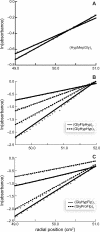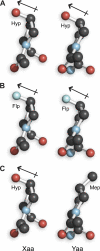Interstrand dipole-dipole interactions can stabilize the collagen triple helix
- PMID: 21482820
- PMCID: PMC3123058
- DOI: 10.1074/jbc.M110.199984
Interstrand dipole-dipole interactions can stabilize the collagen triple helix
Abstract
The amino acid sequence of collagen is composed of GlyXaaYaa repeats. A prevailing paradigm maintains that stable collagen triple helices form when (2S)-proline (Pro) or Pro derivatives that prefer the C(γ)-endo ring pucker are in the Xaa position and Pro derivatives that prefer the C(γ)-exo ring pucker are in the Yaa position. Anomalously, an amino acid sequence in an invertebrate collagen has (2S,4R)-4-hydroxyproline (Hyp), a C(γ)-exo-puckered Pro derivative, in the Xaa position. In certain contexts, triple helices with Hyp in the Xaa position are now known to be hyperstable. Most intriguingly, the sequence (GlyHypHyp)(n) forms a more stable triple helix than does the sequence (GlyProHyp)(n). Competing theories exist for the physicochemical basis of the hyperstability of (GlyHypHyp)(n) triple helices. By synthesizing and analyzing triple helices with different C(γ)-exo-puckered proline derivatives in the Xaa and Yaa positions, we conclude that interstrand dipole-dipole interactions are the primary determinant of their additional stability. These findings provide a new framework for understanding collagen stability.
Figures





Similar articles
-
The crystal structure of the collagen-like polypeptide (glycyl-4(R)-hydroxyprolyl-4(R)-hydroxyprolyl)9 at 1.55 A resolution shows up-puckering of the proline ring in the Xaa position.J Biol Chem. 2005 May 27;280(21):20397-403. doi: 10.1074/jbc.M501453200. Epub 2005 Mar 22. J Biol Chem. 2005. PMID: 15784619
-
Hydroxyproline Ring Pucker Causes Frustration of Helix Parameters in the Collagen Triple Helix.Sci Rep. 2015 Jul 29;5:12556. doi: 10.1038/srep12556. Sci Rep. 2015. PMID: 26220399 Free PMC article.
-
Glycosylation/Hydroxylation-induced stabilization of the collagen triple helix. 4-trans-hydroxyproline in the Xaa position can stabilize the triple helix.J Biol Chem. 2000 Aug 11;275(32):24466-9. doi: 10.1074/jbc.M003336200. J Biol Chem. 2000. PMID: 10827193
-
Pairwise interactions in collagen and the design of heterotrimeric helices.Curr Opin Chem Biol. 2013 Dec;17(6):960-7. doi: 10.1016/j.cbpa.2013.10.019. Epub 2013 Nov 16. Curr Opin Chem Biol. 2013. PMID: 24252327 Review.
-
Hierarchical Assemblies of Collagen-Mimetic Peptides: From a Fundamental Understanding to Developing Biomaterials.Langmuir. 2025 Apr 15;41(14):9162-9185. doi: 10.1021/acs.langmuir.5c00541. Epub 2025 Apr 4. Langmuir. 2025. PMID: 40184430 Review.
Cited by
-
Polyproline and triple helix motifs in host-pathogen recognition.Curr Protein Pept Sci. 2012 Dec;13(8):855-65. doi: 10.2174/138920312804871157. Curr Protein Pept Sci. 2012. PMID: 23305370 Free PMC article. Review.
-
Contrasting Local and Macroscopic Effects of Collagen Hydroxylation.Int J Mol Sci. 2021 Aug 23;22(16):9068. doi: 10.3390/ijms22169068. Int J Mol Sci. 2021. PMID: 34445791 Free PMC article.
-
Thioamides in the collagen triple helix.Chem Commun (Camb). 2015 Jun 14;51(47):9624-7. doi: 10.1039/c5cc02685g. Chem Commun (Camb). 2015. PMID: 25967743 Free PMC article.
-
How Water in Aliphatic Solvents Directs the Interference of Chemical Reactivity in a Supramolecular System.J Am Chem Soc. 2020 Jul 15;142(28):12400-12408. doi: 10.1021/jacs.0c04962. Epub 2020 Jun 30. J Am Chem Soc. 2020. PMID: 32543841 Free PMC article.
-
Subwavelength hyperspectral THz studies of articular cartilage.Sci Rep. 2018 May 2;8(1):6924. doi: 10.1038/s41598-018-25057-9. Sci Rep. 2018. PMID: 29720708 Free PMC article.
References
Publication types
MeSH terms
Substances
Grants and funding
LinkOut - more resources
Full Text Sources

